Page 37 of 474
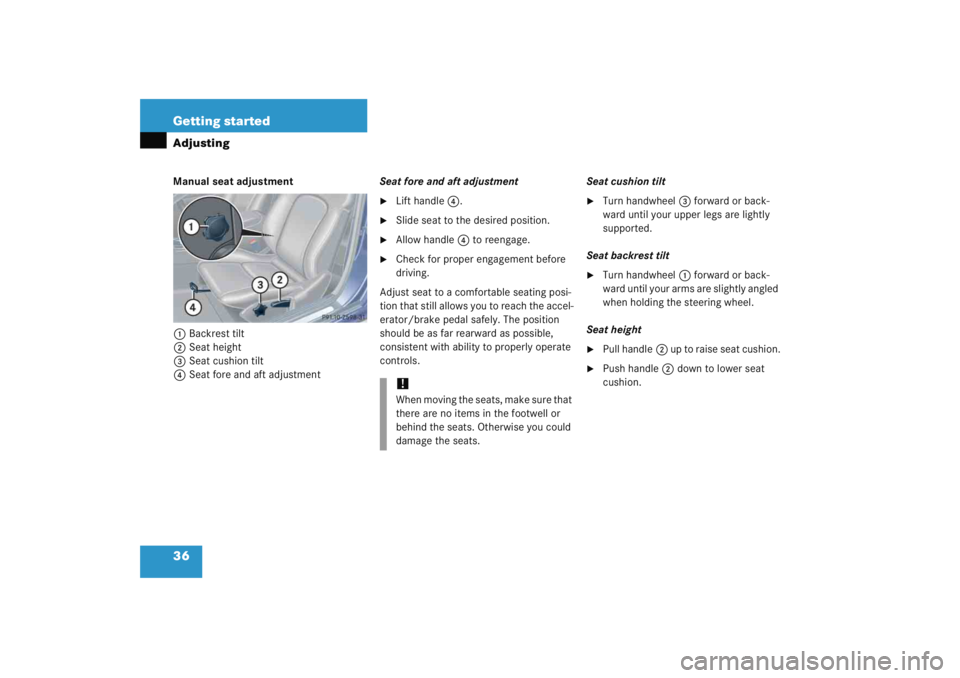
36 Getting startedAdjustingManual seat adjustment1 Backrest tilt
2 Seat height
3 Seat cushion tilt
4 Seat fore and aft adjustment Seat fore and aft adjustment
�
Lift handle
4.
�
Slide seat to the desired position.
�
Allow handle 4 to reengage.
�
Check for proper engagement before
driving.
Adjust seat to a comfortable seating posi-
tion that still allows you to reach the accel-
erator/brake pedal safely. The position
should be as far rearward as possible,
consistent with ability to properly operate
controls. Seat cushion tilt
�
Turn handwheel
3 forward or back-
ward until your upper legs are lightly
supported.
Seat backrest tilt
�
Turn handwheel 1 forward or back-
ward until your arms are slightly angled
when holding the steering wheel.
Seat height
�
Pull handle 2 up to r ai se s ea t cus hi on.
�
Push handle 2 down to lower seat
cushion.
!W h e n m o v i n g t h e s e a t s , m a k e s u r e t h a t
there are no items in the footwell or
behind the seats. Otherwise you could
damage the seats.
Page 39 of 474
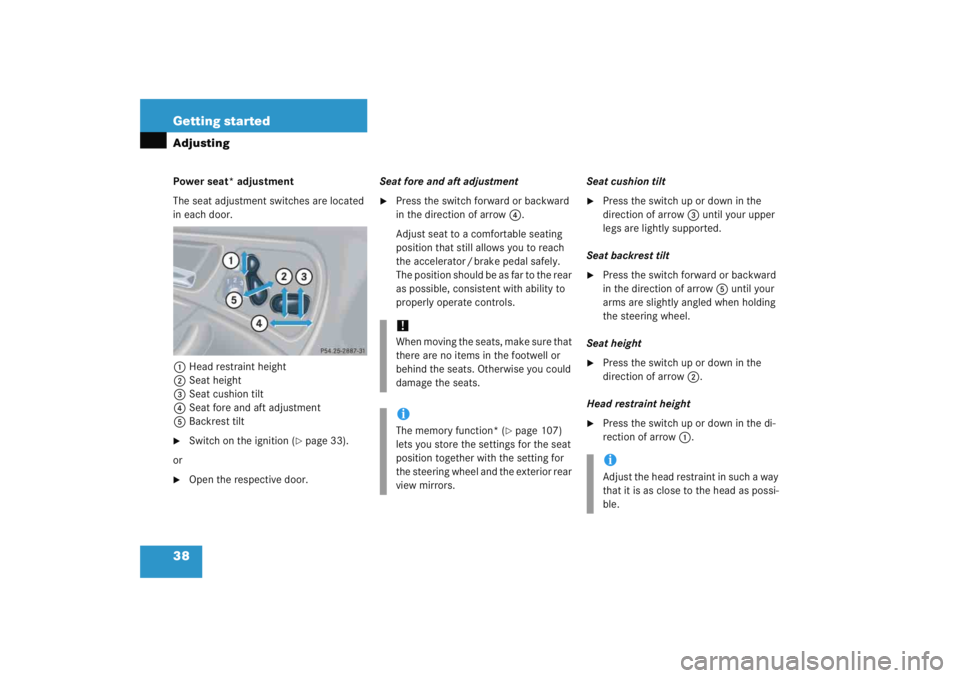
38 Getting startedAdjustingPower seat* adjustment
The seat adjustment switches are located
in each door.1 Head restraint height
2 Seat height
3 Seat cushion tilt
4 Seat fore and aft adjustment
5 Backrest tilt�
Switch on the ignition (
�page 33).
or
�
Open the respective door. Seat fore and aft adjustment
�
Press the switch forward or backward
in the direction of arrow
4.
Adjust seat to a comfortable seating
position that still allows you to reach
the accelerator / brake pedal safely.
The position should be as far to the rear
as possible, consistent with ability to
properly operate controls. Seat cushion tilt
�
Press the switch up or down in the
direction of arrow
3 until your upper
legs are lightly supported.
Seat backrest tilt
�
Press the switch forward or backward
in the direction of arrow 5 until your
arms are slightly angled when holding
the steering wheel.
Seat height
�
Press the switch up or down in the
direction of arrow 2.
Head restraint height
�
Press the switch up or down in the di-
rection of arrow 1.
!W h e n m o v i n g t h e s e a t s , m a k e s u r e t h a t
there are no items in the footwell or
behind the seats. Otherwise you could
damage the seats.iThe memory function* (
�page 107)
lets you store the settings for the seat
position together with the setting for
the steering wheel and the exterior rear
view mirrors.
iAdjust the head restraint in such a way
that it is as close to the head as possi-
ble.
Page 41 of 474
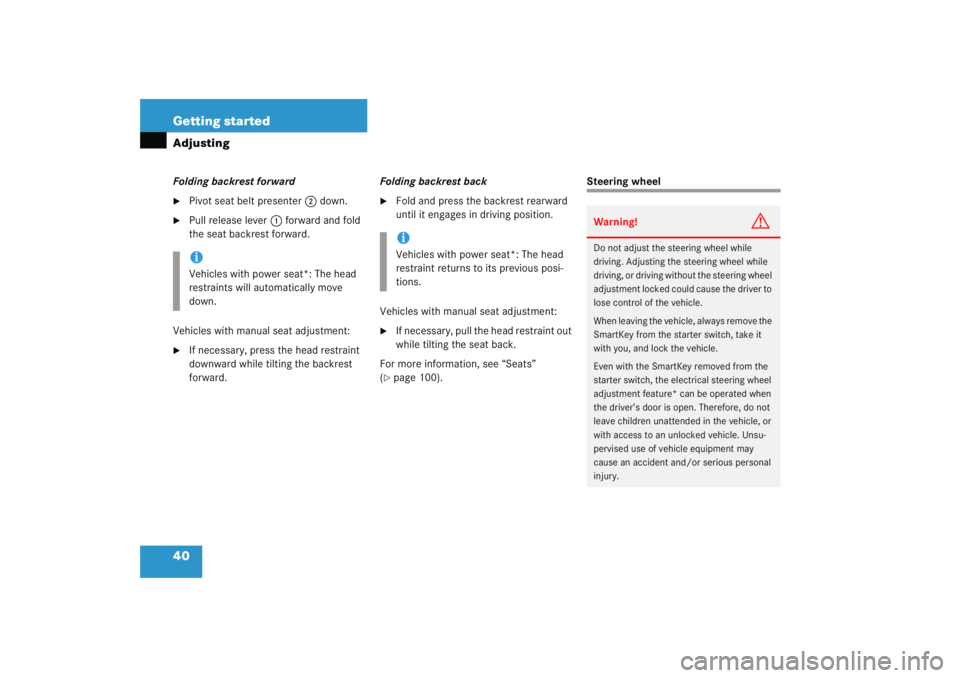
40 Getting startedAdjustingFolding backrest forward�
Pivot seat belt presenter2 down.
�
Pull release lever 1 forward and fold
the seat backrest forward.
Vehicles with manual seat adjustment:
�
If necessary, press the head restraint
downward while tilting the backrest
forward. Folding backrest back
�
Fold and press the backrest rearward
until it engages in driving position.
Vehicles with manual seat adjustment:
�
If necessary, pull the head restraint out
while tilting the seat back.
For more information, see “Seats”
(
�page 100).
Steering wheel
iVehicles with power seat*: The head
restraints will automatically move
down.
iVehicles with power seat*: The head
restraint returns to its previous posi-
tions.
Warning!
G
Do not adjust the steering wheel while
driving. Adjusting the steering wheel while
driving, or driving without the steering wheel
adjustment locked could cause the driver to
lose control of the vehicle.
When leaving the vehicle, always remove the
SmartKey from the starter switch, take it
with you, and lock the vehicle.
Even with the SmartKey removed from the
starter switch, the electrical steering wheel
adjustment feature* can be operated when
the driver’s door is open. Therefore, do not
leave children unattended in the vehicle, or
with access to an unlocked vehicle. Unsu-
pervised use of vehicle equipment may
cause an accident and/or serious personal
injury.
Page 42 of 474

41
Getting started
Adjusting
Steering wheel adjustment, manual
1 Handle�
To unlock the steering column, pull
handle 1 out until its stop limit.
�
Move steering wheel to the desired
position.
�
To lock the steering column, push
handle 1 all the way in until it
engages.
The steering wheel is once again
locked into position.
�
Make sure the steering wheel is
securely locked by trying to move it up
and down, and in and out before driving
off.
Make sure your legs can move freely and
that all the displays (inclusive malfunction
and indicator lamps) on the instrument
cluster are clearly visible. Steering wheel adjustment, electrical*
The stalk for steering wheel adjustment is
located on the steering column (lower left).
1 Adjusting steering column, in or out
2 Adjusting steering column, up or down
�
Switch on the ignition (
�page 33).
or
�
Open the driver’s door.
Warning!
G
Only adjust the steering wheel with the vehi-
cle at a standstill and make sure the steer-
ing wheel is securely locked in place before
driving off.
Driving without the steering wheel adjust-
ment locked may cause an unexpected
steering wheel movement which could
cause the driver to lose control of the vehi-
cle. Make sure the steering wheel is secure-
ly locked by trying to move it up and down,
and in and out before driving off.
Page 43 of 474
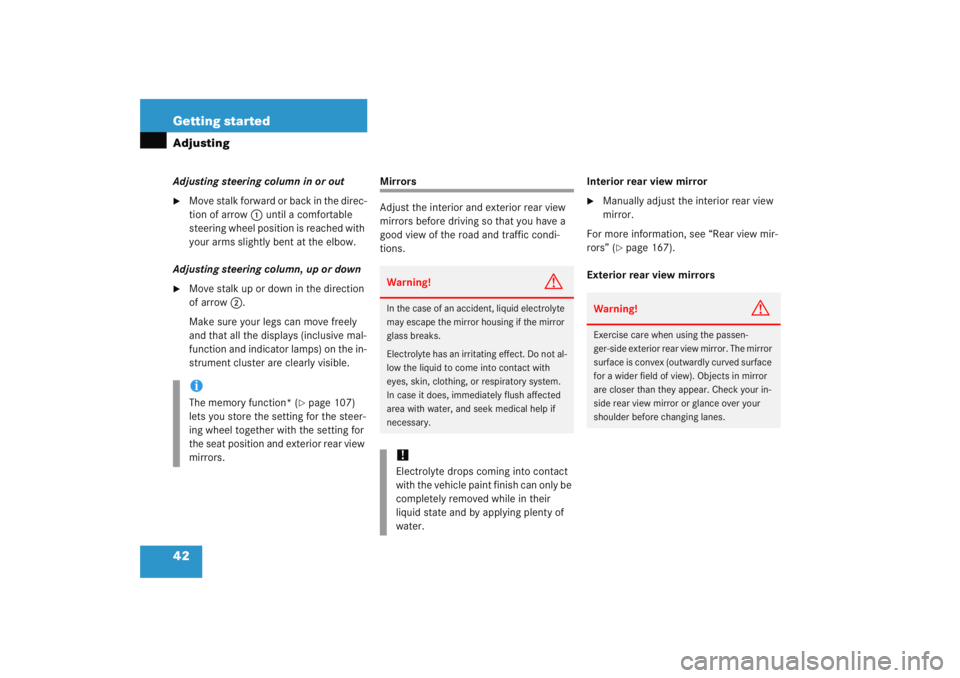
42 Getting startedAdjustingAdjusting steering column in or out�
Move stalk forward or back in the direc-
tion of arrow1 until a comfortable
steering wheel position is reached with
your arms slightly bent at the elbow.
Adjusting steering column, up or down
�
Move stalk up or down in the direction
of arrow 2.
Make sure your legs can move freely
and that all the displays (inclusive mal-
function and indicator lamps) on the in-
strument cluster are clearly visible.
Mirrors
Adjust the interior and exterior rear view
mirrors before driving so that you have a
good view of the road and traffic condi-
tions. Interior rear view mirror
�
Manually adjust the interior rear view
mirror.
For more information, see “Rear view mir-
rors” (
�page 167).
Exterior rear view mirrors
iThe memory function* (
�page 107)
lets you store the setting for the steer-
ing wheel together wi th the setting for
the seat position and exterior rear view
mirrors.
Warning!
G
In the case of an accident, liquid electrolyte
may escape the mirror housing if the mirror
glass breaks.
Electrolyte has an irritating effect. Do not al-
low the liquid to come into contact with
eyes, skin, clothing, or respiratory system.
In case it does, immediately flush affected
area with water, and seek medical help if
necessary.!Electrolyte drops coming into contact
with the vehicle paint finish can only be
completely removed while in their
liquid state and by applying plenty of
water.
Warning!
G
Exercise care when using the passen-
ger-side exterior rear view mirror. The mirror
surface is convex (outwardly curved surface
for a wider field of view). Objects in mirror
are closer than they appear. Check your in-
side rear view mirror or glance over your
shoulder before changing lanes.
Page 44 of 474
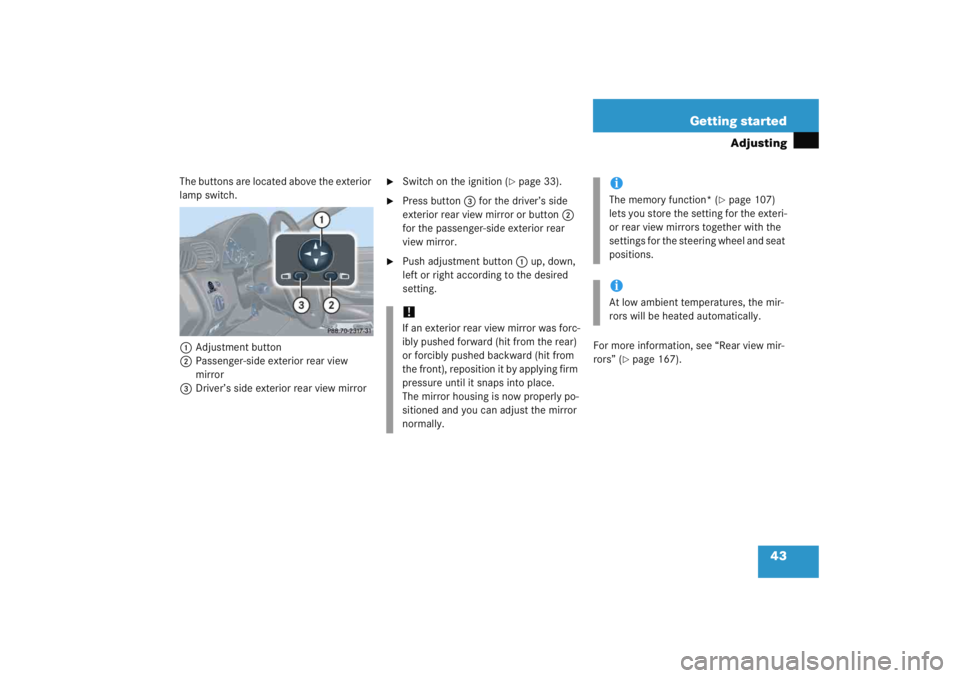
43
Getting started
Adjusting
The buttons are located above the exterior
lamp switch.
1 Adjustment button
2 Passenger-side exterior rear view
mirror
3 Driver’s side exterior rear view mirror
�
Switch on the ignition (
�page 33).
�
Press button 3 for the driver’s side
exterior rear view mirror or button 2
for the passenger-side exterior rear
view mirror.
�
Push adjustment button 1 up, down,
left or right according to the desired
setting.
For more information, see “Rear view mir-
rors” (
�page 167).
!If an exterior rear view mirror was forc-
ibly pushed forward (hit from the rear)
or forcibly pushed backward (hit from
the front), reposition it by applying firm
pressure until it snaps into place.
The mirror housing is now properly po-
sitioned and you can adjust the mirror
normally.
iThe memory function* (
�page 107)
lets you store the setting for the exteri-
or rear view mirrors together with the
settings for the steering wheel and seat
positions.
iAt low ambient temperatures, the mir-
rors will be heated automatically.
Page 52 of 474

51
Getting started
Driving
After a cold start, the automatic transmis-
sion shifts at a higher engine revolution.
This allows the catalytic converter to reach
its operating temperature earlier.
For more information on driving, see “Driv-
ing instructions” (
�page 277).
Switching on headlamps
For more information on headlamps, see
“Lighting” (
�page 110).
Low beam headlamps
The exterior lamp switch is located on the
dashboard to the left of the steering wheel.
Exterior lamp switch1 Off
2 Low beam headlamps on
Warning!
G
On slippery road surfaces, never downshift
in order to obtain braking action. This could
result in drive wheel slip and reduced vehi-
cle control. Your vehicle’s ABS will not pre-
vent this type of loss of control.!Vehicles with automatic transmission*:
Place the gear selector lever in
position P or R only when the vehicle is
stopped in order to avoid damaging the
transmission.
!Do not run cold engine at high engine
speeds. Running a cold engine at high
speeds may shorten the service life of
the engine.Warning!
G
Vehicles with automatic transmission*: It is
dangerous to shift the gear selector lever
out of P or N if the engine speed is higher
than idle speed. If your foot is not firmly on
the brake pedal, the vehicle could acceler-
ate quickly forward or in reverse. You could
lose control of the vehicle and hit someone
or something. Only shift into gear when the
engine is idling normally and when your right
foot is firmly on the brake pedal.
Page 53 of 474

52 Getting startedDriving�
Turn the exterior lamp switch to
positionB.
The low beam headlamp indicator
lamp B in the instrument cluster
comes on (
�page 24).
High beam
The combination switch is located on the
left of the steering column.
Combination switch1 High beam
2 High beam flasher
�
Push the combination switch in
direction of arrow 1.
The high beam headlamp indicator
lamp A in the instrument cluster
comes on (
�page 24).
For more information on headlamps, see
“Combination switch” (
�page 114).
Turn signals
The combination switch is located on the
left of the steering column.Combination switch1 Turn signals, right
2 Turn signals, left
�
Press combination switch in direction
of arrow 1 or 2.
The corresponding turn signal indicator
lamp L or K in the instrument
cluster flashes.
The combination switch resets auto-
matically after major steering wheel
movements.iTo signal minor directional changes,
such as changing lanes, press combi-
nation switch only to point of resis-
tance and release. The corresponding
turn signal will flash three times.